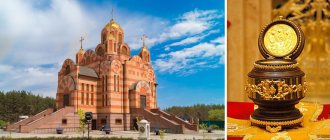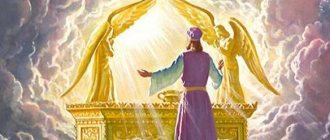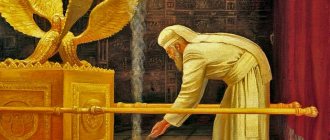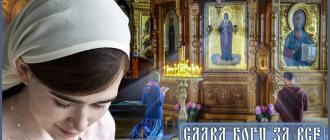- The life path of the righteous Anna
- Veneration of the ascetic
- Saint Anna the Prophetess - what she helps with
The New Testament praises many virtuous, fearless and pleasing ascetics. Some of them accompanied the Lord and spread His word throughout the entire earth, while others prepared the way for the Savior, announcing His coming mission. The latter also includes Saint Anna, who will be discussed in this article - and it is also described here in which cases you will need an amber icon depicting the preacher!
The life path of the righteous Anna
Anna (translated from Hebrew her name, “Ἄννα”, means “merciful”) came from the tribe of Asher - the descendants of the 8th son of the patriarch Jacob. They owned fertile lands to the west of the Euphrates, as well as the area from the Jordan to the shores of the Mediterranean Sea. This territory almost did not suffer from natural disasters and produced generous harvests, so representatives of this tribe did not seek to conquer other states and were distinguished by their sincerity and peace-loving nature.
Such character traits were also inherent in the girl who was born into the family of a rich, but at the same time meek and God-fearing merchant Phanuel. The baby always listened to the instructions of her parents, was calm, diligent and kind - a prayer of praise to St. Anna the Prophetess reminds us of this. The girl got married early, but lived with her husband for only 7 years - he died of a sudden illness. After the death of her beloved, the woman devoted herself to earnest service to the Creator, and soon settled at the Jerusalem Temple. The ascetic remained there until she was 84 years old, helping all the poor, the weak and the suffering to the best of her ability.
According to the Gospel of Luke (Luke 2:36-38), the righteous woman was in the cathedral on that wonderful day when Joseph the Betrothed and the Mother of God brought Jesus there, intending to offer a sacrifice to the Lord for their first-born son. Also there was Simeon the God-Receiver, a learned Jew who translated the book of the prophet Isaiah, and, having read there the phrase: “The virgin will receive and give birth to a Son,” he decided to correct them, considering them a mistake. But before he changed the word “Virgo” to “Wife,” a shining angel appeared before the sage, saying that everything written was true; and he also promised that the man would not die until he witnessed the prediction come true.
And so it happened - taking the baby Christ in his arms, Simeon bowed to him, saying: “Now you are releasing Your servant, Master,” and called him “salvation prepared in the face of all nations” and “the glory of Israel.” The ascetic did the same - this episode is often depicted in the icon of St. Anne and religious paintings on a similar topic. Having received the great honor of seeing the Creator, the righteous woman began to talk about Him throughout the city - for this she is called a “prophetess,” the only one among all the women spoken of in the New Testament.
ANNA
Anna the Prophetess with baby Samuel. Initial from the Constantinople Psalter. XI century (RNB)
Anna the Prophetess with baby Samuel. Initial from the Constantinople Psalter. XI century (RNB)
St. 11th century prophetess BC (mem. Dec. 9), mother of the prophet. Samuel (1 Samuel 1. 1-2. 11). One of the 2 wives of the Levite Elkanah of Ramathaim-Zophim (see Rama). Being childless, A. experienced oppression from her other wife, Pennana. A.'s infertility and her tragic situation are reminiscent of Sarah's situation (Gen. 16). During the annual pilgrimage to Shiloh, A. made a vow: if God sends a son, he will devote him to the Lord “all the days of his life.” Among the many praying St. Eli drew attention to A.’s quiet prayer and assured the woman that her request would be fulfilled and she would give birth to a son. A.’s promise that “no razor will touch his head” (1 Kings 1.11) indicates her desire to consecrate her son to a Nazarite (cf. Numbers 6.1-21; Ancient Jude V 10.3). After 3 years, the son she gave birth to named Samuel was brought to Eli and dedicated to serving the Lord. A. puts the feeling of gratitude to God for allowing her to give birth to a son in the “Song of Praise” - an example of ancient biblical poetry. A.'s song conveys a state of deep reverence and humility when contemplating the mysteries of Divine Providence (1 Kings 2.1-10). The words of A.: “The Lord will judge the ends of the earth and will give strength to His king” (1 Samuel 2.10) - prophetically point to King David, (1877-1937) representatively - to the Lord Jesus Christ. In the 10th verse of the song for the first time in St. The Scriptures mention the anointed one (Greek χριστός). The closest parallel to the Song of A. in the OT is the Song of David (2 Sam. 22): the first 3 stanzas of the 8th verse of the Song of A. are almost identical to Ps 122. 7-8. At the same time, the psalmist skillfully supplements this text with certain details from the story of A.: “[The Lord] brings the barren woman into the house as a mother who rejoices over the children” (cf. the mention in 1 Samuel 2.21 about the birth of A. after the firstborn, 3 more sons and 2 daughters). A.'s Song served as a prototype for the Song of the Most Holy. Theotokos (Luke 1.46-55; see Song of the Virgin Mary; Magnificat) - certain themes from the 1st are repeated in the 2nd (cf.: 1 Kings 2.4, 7-8 and Luke 1.52; 1 Kings 2.5 and Luke 1.53). A.'s story is reflected in the story of the apocryphal Proto-Gospel of Jacob about the birth of the Most Holy One. Mother of God. St. John Chrysostom calls A. “a ray of virtues, adorned with prayer, faith and great patience” (Five Words about Anna. III 1). In the beginning. XIX century St. Nicodemus the Svyatogorets summarized the patristic interpretation of the Song of A. in his book. "The Garden of Grace, or Interpretation of 9 Biblical Songs."
Lit.: Biblical women // PO. 1889. No. 11/12. pp. 770-789; John Chrysostom, St. Five words about Anna // Complete. collection creations. St. Petersburg, 1898. M., 1995. T. 4. Book. 2. P. 801; Elbogen I. Der Jüdische Gottesdienst in seiner geschichtlichen Entwicklung. Lpz., 1913; Hamp V. Der alttestamentliche Hintergrund der Magnificat // Bibel und Kirche. 1952. T. 32. S. 17-23; Νικόδημος ῾Αγιορείτης. Κῆπος Χαρίτων, ἥτοι ἑρμηνεία γλαφύρα εἰς τὰς Θ´ ᾤδας τῆς στιχολογί ας. Βόλος, 1958; Apocrypha of ancient Christians. M., 1989. P. 118; Youngblood R. Hannah // ABD.
Holy Afanasy Gumerov
Hymnography
Memory A. is rarely found in monthly books (Sergius (Spassky). Monthly book. T. 2. P. 380), the sequence is unknown. In Greek The printed Menea, based on the 6th canon of the Matins canon, contains the verse synaxarion of A. (Μηναῖον. Δεκέμβριος. Σ. 124). A. is mentioned in the hymnographic texts of the service of the prophet. Samuel (Aug. 20), in the irmos of certain canons. September 5, on the day of memory of Zechariah and Elizabeth, parents of St. John the Baptist, as the 3rd paremia of Vespers, an excerpt from 1 Samuel 1 is read. 9-20 - A.’s prayer for the granting of a son to her.
A.'s song in worship.
Song of A. (1 Kings 2. 1-10; Greek text: Rahlfs A. Septuaginta. T. 2. P. 169-170; liturgical Church Orthodox text: Irmology. Book 1. pp. 132-133, 140, 149-150) is present among other biblical songs in the Alexandrian Codex (5th century), where it is placed between the 2nd Song of the Prophet. Moses (Deut. 32) and one of the Songs of the Prophet. Isaiah (Isaiah 26.1-19) - following, it was used in the Alexandrian worship. In the Jerusalem service, the Song of A. was sung at matins: initially - on Wednesdays (Sir. Psalter of the 8th century, reflecting the liturgical practice of the 6th century - RNL. Sir. new series 19; according to R. Taft - on Tuesdays (RF Taft )), later (according to the Georgian Jerusalem Iadgari) took 3rd place in the structure of the hymnographic canon (between the 2nd Song of the Prophet Moses and the Song of the Prophet Habakkuk); This place remained with her even in Byzantium. rite. According to the current Typikon time The Song of A. should be sung daily at Matins, often in an abbreviated form; the entire 16 verses (the liturgical breakdown into verses does not coincide with the biblical one) are sung only on Wednesdays of Lent. In Greek and glory In the Followed Psalms, the Song of A. is entitled “”, chorus: “” (The Followed Psalter. T. 2. P. 71), apparently, was used before the widespread dissemination of the Trisongs and canons.
In the system of services of the daily circle of the Benedictine rite and in other countries. systems of daily circle services based on it, in the succession of daily circle services since the time of St. Venedicta (VI century) A.'s song was sung on Tuesdays at Laudes. In Ethiopian Psalter (Mezmure Dawit we celotat ze nabijat. Addis Abeba, 1962. P. 309-312; see Ethiopian Church) it is located between the “third” Song of the prophet. Moses from Deuteronomy (Deut. 32.22-43) and the prayer of Hezekiah, king of Judah (Is. 38). Song of A. is used in Western Sir. worship: in the Maronite Church - at matins, in the Syro-Jacobite Church - in the rite of Tikrit (night service) (Mateos. Les matines.).
The content of Song A. is paraphrased in the irmos of the 3rd song of the canons: “” (Great Canon of St. Andrew of Crete), “” (canon of St. Cosmas of Maium from the service of St. Gregory the Theologian, January 25), “” (Sunday canon 2 -th plagal, i.e. 6th, voice of St. John of Damascus). The most frequently used lines from Song A.: "", "".
Lit.: Skaballanovich. Explanatory Typikon. Part 2. pp. 259-260; Fortesque A. Canon dans le rite byzantine // DACL. Vol. 3. Col. 134-150; Τομαδάκης Ν. ῾Η ἐκκλησιαστικὴ ἡμῶν ποίησις καὶ ἡ συμφωνία αὐτῆς πρὸς τὸ δόγμα καὶ τὰ κείμενα τῶν Γραφῶν. ̓Αθῆναι, 1949; Lods A. Histoire de la littérature hebraique et juive depuis les origines jusqu' à la ruine de l'État juif. P., 1950; Mateos J. Les matines chaldéenes, maronites et syrienes // OCP. 1960. Vol. 26. P. 70-71; idem. Quelques problemes de l'Orthros byzantin // Proche Orient Chrétien. 1961. Vol. 11. P. 31-32; Grelot P. Sens chrétien de l'Ancien Testament. Tournai, 1962; Pigulevskaya N.V. Syrian manuscripts of Leningrad // Teaching staff. 1965. No. 6. P. 12; Ancient Iadgari / Ed. E. N. Metreveli, T. A. Chankieva, L. M. Khevsuriani. Tbilisi, 1980; Taft RF Mount Athos: A Late Chapter in the History of the Byzantine Rite // DOP. 1988. Vol. 42. P. 188-190.
IN . IN . Vasilik
Iconography
Images of A. are mainly known in the Byzantine era. illustrated manuscripts - Minologies (on December) and Psalms (before the Song of A.), where the prayer of the saint is presented: in the Khludov Psalter (GIM. Greek 129; 9th century) - with the baby Samuel in her arms; in the Constantinople Psalter (RNB. Greek 214. L. 306 vol.; 11th century) - the figure of A., stretching out her hands to Samuel, is inscribed in the initial “E”; NT with Psalter (GIM. Gr. 407; XIV century); in Greco-cargo. manuscript (RNB. OI 58. L. 89 vol., 15th century) - with hands raised in prayer, etc. Sometimes A. is represented kneeling, with hands raised in prayer (Laur. Cod. B 26. Fol. 264a; XII -XIII centuries; Vatop. Cod. 851. Fol. 186a; XII-XIII centuries). In a number of manuscripts (Washington. Dumbarton Oaks. Cod. 3. Fol. 75; ca. 1084; Paris. Cod. 610; 11th century) the saint is depicted twice: in prayer and on the throne with the baby Samuel on her lap.
Iconography: Buchtal H. The Miniatures of the Paris Psalter: A Study in Middle Byzantine Painting. L., 1938; Likhacheva V.D. Byzantine miniature. M., 1977; Cutler A. The Aristocratic Baltersin Byzantium. P., 1981; Evseeva. Athos book. P. 257.
S. P. Zaigraykina
Veneration of the ascetic
On the first icons, the wise old woman was depicted as a gray-haired woman with a gaunt, thin face, dressed in a tunic, a phelonion (the outer vestment of an Orthodox priest) and a head veil worn by widows. As a rule, she (full face or in profile) was located behind the back of the Virgin Mary, pointing to Jesus Christ with her right hand.
Later, masters began to create individual relics. On them, the righteous woman holds a scroll, where words about the deliverance of all living in Jerusalem or a line from the Christian missal: “He who created heaven and earth” are inscribed in Church Slavonic or Greek. You also have the opportunity to buy an icon of St. Anne with another of its attributes - a candle.
The memory of the ascetic is celebrated on September 10 (according to the old style - August 28). In addition, the chapter from the Gospel, which describes the deeds of the righteous woman, is read on Candlemas (February 15), and she herself, together with Simeon the God-Receiver, is remembered on the post-feast day, February 16.
3.1. Books of Kings and Chronicles
The next books are four books of Kings and two Chronicles. The first two books of Kings in the Jewish tradition are called the book of Samuel, and the third and fourth books of Kings are called the book of kings. This division is common in many modern Western editions of the Bible, so if you work with Western editions, be aware that their 1st and 2nd Kings correspond to the 3rd and 4th books in our tradition.
The narrative of the books of Kings covers the period from the ministry of the prophet Samuel and the establishment of a monarchy among the Israelites until the fall of the kingdom, which was divided into Northern and Southern. The fall of the Northern Kingdom, then the fall of the Southern Kingdom and the taking of most of the Israelis into captivity, the defeat of Jerusalem, the end of the independent political existence of the Kingdoms of Israel and Judah, and some indications about the fate of the captives in Babylon - this is the content of these books. This period took 500 years, from the end of the 11th century to the beginning of the 6th century BC.
Holy Righteous Anna the Prophetess
The name Anna was very popular among the Russian princes. Suffice it to recall the daughter of Prince Yaroslav the Wise, Anna Yaroslavna, who married the French King Henry I, who was struck by the beauty and intelligence of his bride. Anna took an active part in government affairs. This was noted with admiration by Pope Nicholas II, who wrote to her:
“The rumor of great virtues, delightful girl, has reached our ears, and with great joy we hear that you carry out your royal duties with a wonderful mind.”
3.2. High Priest Eli
The narrative of the First Book of Samuel begins with a description of the ministry of Samuel. At this time the ministry of the high priest and the ministry of the judge are combined in one person, namely, in the person of the high priest Eli, who serves at the tabernacle located at Shiloh. A certain barren woman appears to him and prays to God to give her a child. This woman receives an answer to her prayer, the baby Samuel is born, whom his mother promised to dedicate to God. The story of the prophet Samuel begins with such a miracle.
The description of the tabernacle service at this point falls far short of the ideal depicted in the Pentateuch. Everything is simple, there is not even a special mention of the Levites, there is Eli, the high priest, and his two sons. It’s just that during worship, during prayer, this woman communicates with him, he himself approaches her and tries to stop her, suspecting that she came drunk to offer prayers. Perhaps this was due to the unusual nature of her prayer. To the extent that this can now be restored, Jews traditionally prayed out loud and quite loudly. If we look at how prayer is depicted, say, in the Psalter, we will see that a word such as “let us shout” is constantly used there, which indicates a fairly loud pronunciation of prayers. The image of the woman’s mournful prayer differed from the traditional one, which allowed the high priest to assume that she was drunk. Or maybe this was not the only incident of this kind, which fully characterizes this era.








